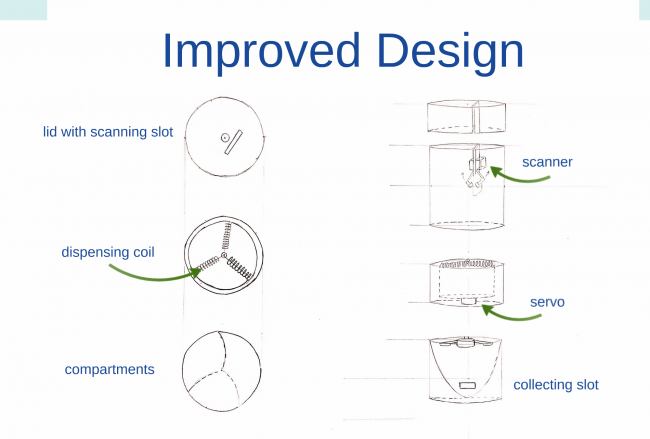Progress Report #7 (2014)
Meeting with Dr. Booth – By Aireen
On 3rd February, we had meeting with our client, Dr. Booth, at The Vanderbilt Clinic. We showed him our latest smart cooler design and he raised some concerns on how to minimize human error when using the cooler. He suggested us to create a cooler that enable us to take blood products out of cooler without having to open the lid. This is to avoid any unfortunate events that may undo all our effort to automatically sort the blood products in their right compartments. After further research and discussion, we then improved our design by installing a dispensing system in our cooler. Instead of opening the lid to take put desired products, the cooler will automatically dispense requested products. Because of this addition, we could not modify the existing cooler and need to design a brand-new cooler. The dispensing system will work similarly to the one in vending machine. However, since we will be building prototype, we will use small scale dispenser that can fit in our cooler.
In addition, we confirmed with Dr. Booth that The Vanderbilt Clinic has the authority to make some changes on the blood bag stickers. This allows us to use RGB scanner instead of OCR scanner because we then can put colored sticker to differentiate each products and sort them based on the color code. Plus, RGB scanner is much smaller compared to OCR and easier to manipulate.
Improved Design – by Zulhilmi
Regarding the concern stated above, we decided to include a dispensing mechanism such that no medical personnel could bypass our scanning and sorting system in order to take the blood products out of the container.
The dispensing system are inspired by the snack vending machine. We planned to implement the dispensing coil into our design because it is simple and is very feasible to be produced.
The coils serve as a rack that can move outwards from the center of the container. Upon scanning and sorting, the coil will be spun to vacate a spot for the entering blood product. The blood product will be kept on the rack until the medical personnel requests for a particular product through the interface. The coil will be spun again until the blood product is moved to the edge of the container and dispensed into the collecting slot.
The image above is the sketch of our improved design. In this design, unfortunately, we’ve eliminated the cooling system from the cooler. This is to focus on the scanning and sorting part of the design. The cooling system will be reanalyzed after we’ve successfully put together our scanning and sorting system.
Components Ordering and Next Week Plan – By Hakim
Once our improved concepts have been proven by Dr. Walker in our last presentation, we moved on to start ordering components. At this stage, we only ordered 3 main components – Arduino Uno Servo 3 (x1), parallax servo motors (x4) and RGB sensor (x1). The rest of the components will be ordered as the design progress.
As mentioned in the previous report, the Arduino Uno will act as the central processing unit for the actions carried out by the components of the design, the servo will rotate to move the dispenser and sorting compartment and the RGB sensor will differentiate the types of blood bags based on specific color attached to them.
We visited RadioShack store at Charlotte Pike, Nashville last Monday to have a closer look at the components. Some of the components needed are unavailable at the store. We filled in the ordering form through the Biomedical Engineering Department and the components are expected to arrive next Wednesday. While waiting for the components, we are planning to design the body. We planned to consult the Mechanical Engineering department to have the permission to use the machining tools and to have some advice from the mechanical engineering professors.

©2024 Vanderbilt University ·
Site Development: University Web Communications